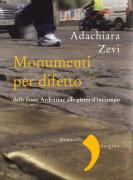Monumenti per difetto

In this reflection on architecture and memory since the Shoah, Adachiara Zevi offers us a history of "by default" monuments. The memory of the worst, she observes, can hardly accommodate the qualities generally attributed to monu- mentality - uniqueness, statism, hieraticism - in a word, impassibility. The question then is what architecture, what art to invent in the face of such a challenge. Adachiara Zevi shows that memory is architecture: "monumentality" must be tested by what it commemorates, and open the ethical space of introspection and remembrance. We must allow memory to answer two essential imperatives: not to be inert and remote from us, and, consequently, to respect and question the past in order to draw the form of the present. The author describes and analyzes how this memory has been embodied since the end of the Second World War.
The book leads the reader to memorials all over the world, from Rome to Jerusalem, from Washington to Paris, from Berlin to Turin or Milan, and even to the "Stolpersteine", these "stumbling blocks" embedded in the floor in front of the last homes of the victims of Nazism. This history of contemporary architecture in connection with the post-Holocaust sheds new light on the different stages of what Raul Hilberg, the great historian of the destruction of the Jews of Europe, called "the politics of memory". Adachiara Zevi's book thus offers a remarkable interpretation of major trends in contemporary art, and discreetly questions the ideological dimension of memory.